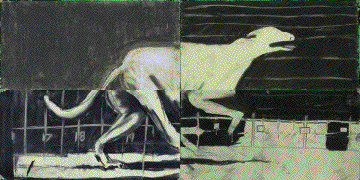
A demonstration of how consistent motion in a sequence can override the variations in drawing styles within the frame and across a series of frames, this GIF is the result of a collaboration among students in the 2008 Evergreen academic program Image and Sequence. Each student made one charcoal drawing of one quarter of one of the twelve photographs in Eadweard Muybridge’s motion study of a whippet running. We scanned them and composited them in After Effects. Each individual drawing measures about 9″ x 18″.
Teaching animation at Evergreen involves designing syllabi that integrate animation techniques and principles into various other disciplines. Below are two pieces I’ve written describing approaches I’ve taken for teaching animation in the context of other disciplines.
Teaching Animation in an Interdisciplinary Context
I wrote this essay for the Animation Journal in 2007 describing three different interdisciplinary programs I’ve collaborated on at Evergreen: Emerging Order; What to Make of It?, Animated Visions: Allegories of Resistance, and Marking Time: Rituals, Gestures and Languages of Movement. Since then, I have further explored integrating animation into teaching in the sciences in Animal Morphology, Motion and Mind (2011-12), Trajectories in Animation, Physics and Mathematics (2012-13) and Picturing Plants (2013).
Quantifying and Visualizing Animators’ Styles of Motion: an analytical and pedagogical tool
Art Babbitt is often quoted as saying that “animators follow the laws of physics unless it is funnier otherwise.” In the spirit of this idea, I collaborated with a physics colleague at Evergreen to design a project in which undergraduates in our program Trajectories in Animation, Mathematics and Physics subjected clips of animation to kinematics analysis. The goals of this were for students to strengthen the observational and analytical skills they’d practiced on several real world phenomena using kinematics analysis software and apply them to phenomena in animated worlds in order to begin to develop theories about how and why different animators use or alter the rules of physics in their works. This paper describes the project, summarizes students’ findings and application of them to their own animated works. I also assess this approach as a method for integrating the teaching of physics into the teaching of animation, and vice versa, and for beginning to quantify, visualize and identify stylistic differences in the ways different animators choose to represent motion.
